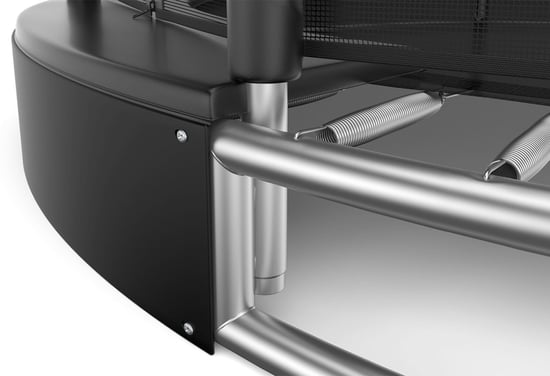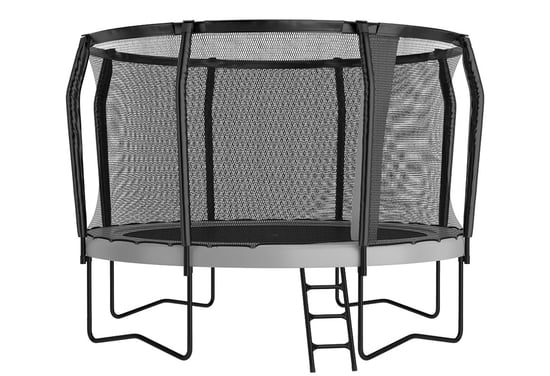Today, the market offers a wide variety of trampolines in different shapes and sizes, made from various materials and designed to cater to different needs. Let's explore the differences between trampolines for public use and family trampolines.
Jumping on trampolines has become extremely popular. Even if your backyard doesn’t have one, trampolines are now considered practically essential at sports parks, campsites, and other tourist attractions, and it’s natural to expect differences between trampolines designed for public use and those intended for families. Are you interested in learning what those differences are?
Purpose
Family trampolines are primarily sought after by families with children, who are looking for suitable sports equipment for active leisure time in their backyards. Family trampolines are thus mainly intended for entertainment and the needs of a single family, including their friends and other visitors.
On the other hand, trampolines for public use cater to a wide range of people seeking additional entertainment in public spaces, such as sports parks, fitness centers, gyms, hotels, urban green areas, or campsites. These types of trampolines accommodate a larger number of people, so they need to withstand higher usage frequency and a greater number of jumps, significantly higher than that seen by family trampolines.

Jumping surface
The jumping surface, also known as the jumping mat, is one of the most important parts of any trampoline, regardless of whether it’s intended for public or family use. Its design and the materials used also determine its rebound properties, so you can expect noticeable differences in this regard.
Trampolines for public use typically feature high-performance jumping mats that are tightly woven and thus less permeable to air. This design ensures greater durability, which is crucial for trampolines intended for public use due to the higher frequency and intensity of usage throughout the day.
The jumping surface of trampolines for public use must also meet all the prescribed standards regarding rebound properties. In this case, the repulsive forces are evenly distributed across the entire surface, enabling them to withstand higher loads.
Family trampolines, on the other hand, have jumping mats with a looser weave, allowing for better air circulation. This is why family trampolines are suitable for household use and fully satisfy the entertainment needs of all ages.
Springs
Springs are also an important part of the jumping surface, as they attach the jumping mat to the trampoline frame. The springs used in family trampolines are identical to those used in trampolines for public use, as high quality is always a priority here.
Regardless of the type of trampoline, they must feature the most innovative spring systems, ensuring long-lasting elasticity, silent operation, and increased bounce with minimal impact on the body.

Frame
Trampoline frames are usually made of hot-dip galvanized steel to prevent rusting and other damage. As the frequency of jumping on trampolines for public use is significantly higher, they feature reinforced double frames that provide maximum stability and resistance to mechanical damage.
Due to potential daily exposure to external factors, the frame is the element that most significantly affects the trampoline's lifespan. The Slovenian trampoline manufacturer Akrobat offers a lifetime warranty on all their trampoline frames.
Size and shape
Trampolines for both public and family use are available in various sizes. Additionally, you can choose between round and rectangular models in both categories. The choice of trampoline size and shape primarily depends on the buyer's preferences, needs, and available space.
Trampolines also differ in their installation methods, with freestanding and in-ground trampolines being the two main types. Freestanding trampolines are easier to set up, making them more common in residential backyards. In-ground trampolines, on the other hand, require proper ground preparation but blend in better with the surroundings, making them more popular in public areas.

Safety net
A safety net is an important safety feature. While in-ground trampoline models typically don’t include a safety net enclosure, it’s an essential element for freestanding trampolines. Whether it's trampolines for public use or family trampolines, the safety net must be UV- and tear-resistant.
Trampolines for public use generally have more durable net enclosures, providing high-quality protection during maximum loads. An additional protective upper ring ensures enhanced safety.
Price
As we’ve discovered, trampolines for public use are designed differently. They allow for long-term, intensive usage, so they’re generally more expensive than family trampolines. On the other hand, a high-quality family trampoline is an excellent choice for a home backyard.
When deciding between trampolines for public or family use, your main focus should be selecting a quality trampoline from a reputable and verified manufacturer, taking into account your own needs and preferences.

